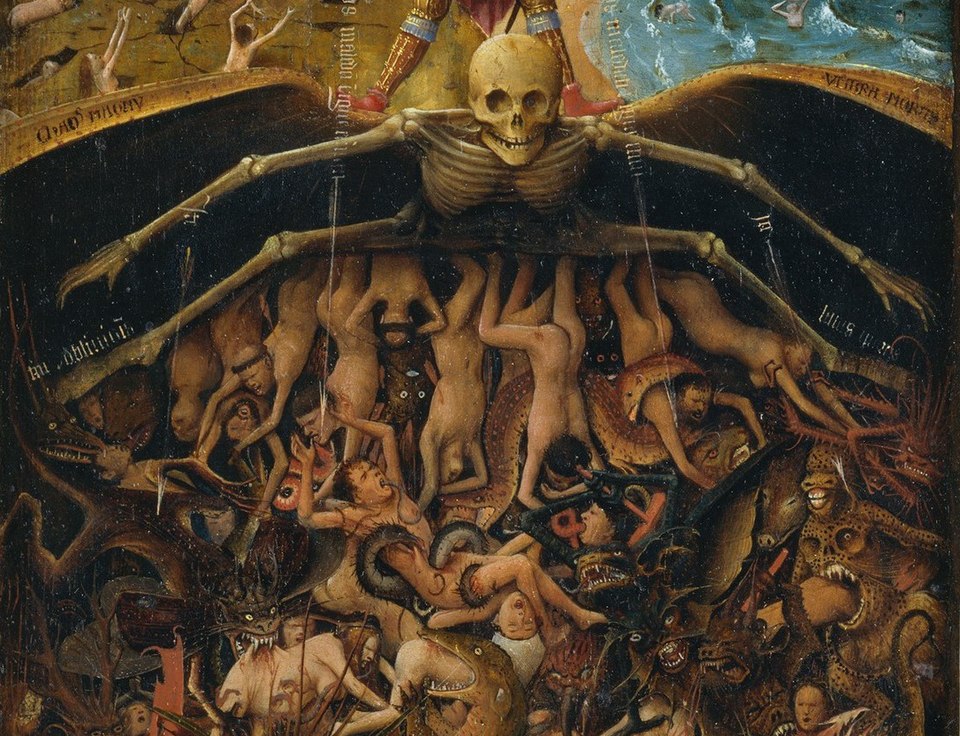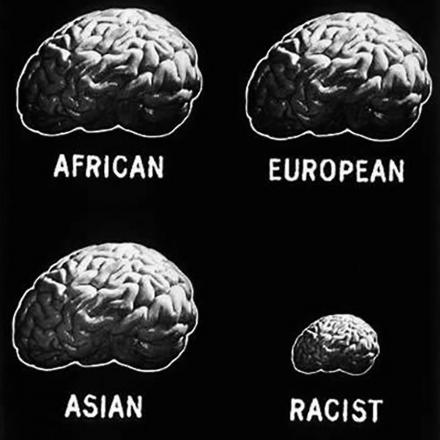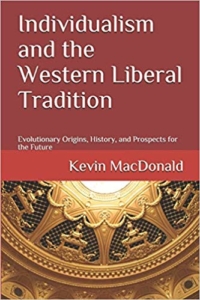Absurdities and Atrocities: How the Arms Races of Animals Can Illuminate the Bullshit of Humans
A specter is haunting America — the specter of a vanished predator.[1] More precisely, it’s haunting the prairies west of the Mississippi, the home of a remarkable antelope called the pronghorn, Antilocapra americana. What’s remarkable about the pronghorn is that it runs far faster than it needs to. No living predator in America gets close to its top speed of 55 mph (88 kph), so some biologists have suggested that the pronghorn is, in effect, running from a dead predator, the long-extinct American cheetah, Miracinonyx spp.
 Speeding from a specter: a pronghorn displays its remarkable speed (image from Wikipedia)
Speeding from a specter: a pronghorn displays its remarkable speed (image from Wikipedia)
If those biologists are right, the pronghorn is the surviving half of an evolutionary arms-race, a competition between predator and prey in which each side had to respond when the other side evolved to be faster. A similar arms-race took place across the Atlantic between African antelopes and the African cheetah, which isn’t in fact closely related to its American namesake.[2] But both groups of cheetahs evolved ever-greater speed to catch ever-fleeter prey. By now, after millions of years of evolution, cheetahs and antelopes must be at the limits of biological possibility. They couldn’t get much faster. Nor could biology ever catch up with one of H.G. Wells’ most memorable short-stories. In “The New Accelerator” (1901), Wells describes the invention of a stimulant drug that makes the body work “several thousand times faster,” “heart, lungs, muscles, brain — everything.”
Power-hungry priests
When the narrator and the inventor take the stimulant and go for what seems to them a stroll, they find that the world of people, animals and objects has, from their point of view, almost frozen to immobility, because they’re moving and perceiving so fast. And when they run, air-friction almost sets their clothes on fire. It’s a highly inventive and entertaining story, but also physiologically absurd (as Wells must have been well aware). After the narrator takes the stimulant, he says: “My heart, for example, was beating a thousand times a second.” But in that case, his heart would have burst. And if his heart and blood-vessels hadn’t burst, his joints and muscles would have disintegrated when he began to move. And so on. Biology can’t be indefinitely accelerated. That’s why biological arms-races between predators and prey haven’t resulted in cheetahs and antelopes that break the sound-barrier.
But if biology can’t be indefinitely accelerated, theology can. Indeed, theology can be infinitely accelerated. I think the concept of an evolutionary arms-race can be applied to the human mind too. For example, some arms-races in theology have gone to infinity — and to absurdity. So have some arms-races in politics and culture.[3] What am I talking about? Well, in theology I’m talking about the concepts of Hell and infallibility. Both of these are big and so-far insurmountable barriers to my becoming a traditionalist Catholic, because I find them absurd and literally unbelievable. But I also find them fascinating as psychological phenomena. And I think I can explain them sociologically and epistemologically. More precisely, I think I can explain them memetically — as conceptual products of a cognitive arms-race, as memes in a Kulturkampf. The concept of Hell, of everlasting punishment in the afterlife, is the product of an arms-race between competing religions or between power-hungry priests and pleasure-hungry layfolk. The point of Hell is to frighten and manipulate. But any religion that used the threat of finite punishment in the afterlife, no matter how prolonged and agonizing, would be out-competed by a religion that used the threat of infinite punishment.
 Obey the Church or be eternally tortured: Jan van Eyck’s 15th-century depiction of Hell (image from Wikipedia)
Obey the Church or be eternally tortured: Jan van Eyck’s 15th-century depiction of Hell (image from Wikipedia)
However, threatening infinitely intense pain would be no good, because we can’t imagine that. But we can imagine infinitely prolonged pain. That’s why even atheists and unbelievers can be disturbed by one section of James Joyce’s autobiographical novel A Portrait of the Artist as a Young Man (1916). Joyce describes a preacher trying to frighten his audience with an utterly absurd but also deeply disturbing vision of Hell. And I think that vision represents the culmination of a conceptual arms-race between priests seeking to frighten and layfolk seeking to resist being frightened:
The preacher’s voice sank. He paused, joined his palms for an instant, parted them. Then he resumed:
—Now let us try for a moment to realise, as far as we can, the nature of that abode of the damned which the justice of an offended God has called into existence for the eternal punishment of sinners. Hell is a strait and dark and foulsmelling prison, an abode of demons and lost souls, filled with fire and smoke. The straitness of this prison house is expressly designed by God to punish those who refused to be bound by His laws. In earthly prisons the poor captive has at least some liberty of movement, were it only within the four walls of his cell or in the gloomy yard of his prison. Not so in hell. There, by reason of the great number of the damned, the prisoners are heaped together in their awful prison, the walls of which are said to be four thousand miles thick: and the damned are so utterly bound and helpless that, as a blessed saint, saint Anselm, writes in his book on similitudes, they are not even able to remove from the eye a worm that gnaws it.
—They lie in exterior darkness. For, remember, the fire of hell gives forth no light. As, at the command of God, the fire of the Babylonian furnace lost its heat but not its light so, at the command of God, the fire of hell, while retaining the intensity of its heat, burns eternally in darkness. It is a neverending storm of darkness, dark flames and dark smoke of burning brimstone, amid which the bodies are heaped one upon another without even a glimpse of air. Of all the plagues with which the land of the Pharaohs were smitten one plague alone, that of darkness, was called horrible. What name, then, shall we give to the darkness of hell which is to last not for three days alone but for all eternity?
—The horror of this strait and dark prison is increased by its awful stench. All the filth of the world, all the offal and scum of the world, we are told, shall run there as to a vast reeking sewer when the terrible conflagration of the last day has purged the world. The brimstone, too, which burns there in such prodigious quantity fills all hell with its intolerable stench; and the bodies of the damned themselves exhale such a pestilential odour that, as saint Bonaventure says, one of them alone would suffice to infect the whole world. The very air of this world, that pure element, becomes foul and unbreathable when it has been long enclosed. Consider then what must be the foulness of the air of hell. Imagine some foul and putrid corpse that has lain rotting and decomposing in the grave, a jellylike mass of liquid corruption. Imagine such a corpse a prey to flames, devoured by the fire of burning brimstone and giving off dense choking fumes of nauseous loathsome decomposition. And then imagine this sickening stench, multiplied a millionfold and a millionfold again from the millions upon millions of fetid carcasses massed together in the reeking darkness, a huge and rotting human fungus. Imagine all this, and you will have some idea of the horror of the stench of hell.
—But this stench is not, horrible though it is, the greatest physical torment to which the damned are subjected. The torment of fire is the greatest torment to which the tyrant has ever subjected his fellow creatures. Place your finger for a moment in the flame of a candle and you will feel the pain of fire. But our earthly fire was created by God for the benefit of man, to maintain in him the spark of life and to help him in the useful arts whereas the fire of hell is of another quality and was created by God to torture and punish the unrepentant sinner. Our earthly fire also consumes more or less rapidly according as the object which it attacks is more or less combustible so that human ingenuity has even succeeded in inventing chemical preparations to check or frustrate its action. But the sulphurous brimstone which burns in hell is a substance which is specially designed to burn for ever and for ever with unspeakable fury. Moreover, our earthly fire destroys at the same time as it burns so that the more intense it is the shorter is its duration; but the fire of hell has this property that it preserves that which it burns and though it rages with incredible intensity it rages for ever. […] And this terrible fire will not afflict the bodies of the damned only from without, but each lost soul will be a hell unto itself, the boundless fire raging in its very vitals. O, how terrible is the lot of those wretched beings! The blood seethes and boils in the veins, the brains are boiling in the skull, the heart in the breast glowing and bursting, the bowels a redhot mass of burning pulp, the tender eyes flaming like molten balls. […]
—O, my dear little brothers in Christ, may it never be our lot to [enter Hell]! May it never be our lot, I say! In the last day of terrible reckoning I pray fervently to God that not a single soul of those who are in this chapel today may be found among those miserable beings whom the Great Judge shall command to depart for ever from His sight, that not one of us may ever hear ringing in his ears the awful sentence of rejection: Depart from me, ye cursed, into everlasting fire which was prepared for the devil and his angels! (James Joyce, Portrait of the Artist as a Young Man, chapter III, 1916)
I’m an unbeliever, but I find that description of Hell disturbing. I also find it both absurd and atrocious.[4] How could any rational person believe in a perfect god and just God who inflicts such a punishment on weak and fallible humans for their finite sins?[5] Well, the simple answer is that Hell isn’t a matter of rationality but of cratology.[6] That’s a useful word meaning “study of power” or “system of power.” The preacher, as proxy for the Church, wants to exercise power over the minds of his audience. And he succeeds very well in one case. Joyce’s alter ego, Stephen Dedalus, is badly frightened by the sermon and after it has a psychosomatic illusion that his “brain [is] simmering and bubbling within the cracking tenement of the skull.” That’s the point of Hell: to frighten. But anything short of an infinitely prolonged Hell isn’t frightening enough or can be out-competed by an infinite Hell. And so, for most of Christian history, the atrocity outweighed the absurdity and the threat of eternal punishment was a potent means of psychological manipulation by the priesthood.[7]
An arms-race with science
There’s no atrocity in another theological concept created by an ideological arms-race. But there is plenty of absurdity. It’s the concept of infallibility, that is, the claim that a religion can offer certain knowledge without any tincture of doubt or uncertainty. I’ve pointed out before that mathematics doesn’t claim infallibility because it doesn’t need to. Math is obviously as close to certain knowledge as fallible and intellectually limited humans can get. Theology, by contrast, is about as far as humans can get from certain knowledge. Our opinions about God and the supernatural are obviously both subjective and arbitrary, in that they’re highly dependant on the time, place and circumstances of our birth. And on our own, unchosen psychology (atheism goes with autism, for example). But one can hardly expect competing religions to admit their own contingency. Instead, competing religions — or ideologies — will enter an epistemological arms-race. The logical culmination of that arms-race is infallibility: the claim that a religion offers complete certainty about all-important matters.
And it’s no coincidence, I’d suggest, that Papal infallibility was proclaimed as dogma in the century that saw the full rise of modern science. In the nineteenth century, Catholicism entered an arms-race with science, which had proved very successful in a physical sense but remained epistemologically modest. Mother Church could not compete materially with science but could compete metaphysically. And so Pius IX proclaimed the absurd concept of Papal infallibility.[8] Protestantism struck back with the even more absurd concept of Biblical inerrancy.[9] And these concepts then influenced secular politics: Leszek Kołokowski, the great Polish philosopher and intellectual historian, said this in his magisterial Main Currents of Marxism (1978): “When the party is identified with the state and the apparatus of power, and when it achieves perfect unity in the shape of a one-man tyranny, doctrine becomes a matter of state and the tyrant is proclaimed infallible. […] Lenin had always been right [and] the Bolshevik party was and had always been infallible.” (Op. cit., Vol 3, p 5) And Italian fascism, which was strongly influenced by Marxism, had the slogan Il Duce ha sempre ragione — “The Duce is always right.”
From pronghorns to perverts
The political concept of infallibility is again the product of an arms-race between competing ideologies. Part of the reason that communism won the arms-race in Russia and fascism won in Italy is that communists and fascists went to infinity. They believed that their leaders and their ideologies weren’t probably or overwhelmingly right, but infinitely right — infallibly right. I think such political and cultural arms-races have continued to this day. But they can be intra-ideological as well as inter-ideological. For example, I think the demand for open borders or defunding of the police is the culmination of an arms-race within the left, not just between the left and the right. Any leftists who support even minimal border-controls leave themselves vulnerable to charges of racism and xenophobia. And so, just as the theological arms-races resulted in the absurd but potent concepts of Hell and infallibility, the intra-leftist arms-race results in the absurd but potent concept of open borders. That is, it’s psychologically potent, because it maximally feeds leftist narcissism and self-regard.
 A leftist absurdity: All races have the same brain and cognitive potential
A leftist absurdity: All races have the same brain and cognitive potential
So do two even more absurd leftist concepts: “Race does not exist” and “Transwomen Are Women.” There have been two more arms-races powered by the fact that accusations of racism or transphobia will shower down on any leftist who questions the Psychic Unity of Mankind or who doesn’t fully accept translunacy. And translunacy itself can be seen as the product of an arms-race between feminists and autogynephiles, that is, men who fetishize themselves as female. Translunacy can also be seen as the product of an arms-race inside the heads of those male fetishists. Before the 1960s and ’70s, men who derived sexual pleasure from dressing and play-acting as women could be dismissed by feminists as exactly what they were: perverted men with an absurd and embarrassing fetish. That’s why those men began to claim that they were real women, not perverted and play-acting men. They were seeking to defeat the feminist critique but also to heighten their own pleasure. An autogynephile who knows he’s play-acting as a woman gets less pleasure than one who manages to convince himself that he really is a woman.
Hacking the hierarchy
Like Hell or infallibility, transgenderism is an absurd concept whose absurdity hasn’t hindered its success. Again, it’s cratology that applies, not rationality. And translunatics have been very successful in pursuing power and winning their arms-race with feminists. Indeed, they’ve been astonishingly successful. As I pointed out in “Power to the Perverts,” some stale pale males in Britain have managed to hack the hierarchy and claim to be victims of hate-crime by a Black lesbian called Linda Bellos. How on Earth did they do that? Under normal circumstances, Bellos would be right at the top of the hierarchy of racial and sexual privilege in leftism. And stale pale males would be right at the bottom. But these stale pale males are “transwomen” and Bellos is a TERF, or Trans-Exclusionary Radical Feminist. Therefore the White men can claim that they are victims of “hate” by the Black lesbian. But since the besting of Bellos, translunacy has suffered setbacks, as I’ve described in “Trashing Traumatized Trannies” and “Moobs on the Move.” The British Supreme Court has ruled that women are defined by biology, not by bullshit.
 The absurdity of autogynephilia: some bearded and balding male perverts invade female territory on a lesbian dating-site
The absurdity of autogynephilia: some bearded and balding male perverts invade female territory on a lesbian dating-site
But the translunatics haven’t gone away and haven’t dropped their absurd claim to be women. They never will drop it, because it’s the product of an arm-race inside their own heads: between sanity and sexual perversion. As you might expect, perversion has prevailed, because sanity and rationality aren’t essential elements of either psychology or cratology. Indeed, they often hinder the pursuit of power, which is why they’re often so conspicuously absent in human affairs. Concepts like Hell and transgenderism are absurd, but their absurdity has mattered much less than their potency. The seemingly disparate concepts of Hell and transgenderism are also united in the way they illustrate a famous principle: “Those who believe in absurdities will commit atrocities.” Those who believed in Hell used it to justify unlimited torture and tyranny. And those who believe in transgenderism have used to justify the mutilation and sterilization of children. As antelopes and cheetahs reveal, a biological arms-race often ends in celerity. As Hell and transgenderism reveal, a cultural arms-race often ends in atrocity.[10]
[1] This is a reference to Marx’s opening line in the Communist Manifesto (1848): “A specter is haunting Europe — the specter of communism.”
[2]American cheetahs seem to have been more closely related to pumas than to African cheetahs.
[3] See also Nassim Taleb’s very interesting essay “The Most Intolerant Wins: The Dictatorship of the Small Minority.”
[4] I also find Hell an immoral or extra-moral concept. If you refrain from bad behavior because you think bad behavior will send you to Hell, you’re not behaving morally. That is, you’re motivated not by abhorrence of sin but by fear of damnation. And if you cease to believe in Hell, you’ll presumably cease to refrain from bad behavior.
[5] I’ve seen the argument that infinite punishment is justified because sin is an offence against an infinite God. This seems to me like arguing that five-year-olds or animals should be punished as adults or humans if they commit an offence against an adult or a human. After all, children and animals can do real harm to their superiors. But how can a human harm God or, in any lasting sense, God’s creation?
[6] Traditional portrayals of Hell and the Crucifixion also owe something to sadism and sexual pathology. The S&M in traditional Catholicism is another thing that keeps me out of Mother Church. It might be easier if I were homosexual: Gerard Manley Hopkins “was horrified to find himself aroused by images of Christ on the cross, and he would scourge himself after erotic dreams.”
[7] Under secular criticism, Hell became embarrassing for the mainstream churches and was increasingly left to the vulgar fringe. You’ve seen above from Joyce how a devout Catholic described Hell at the beginning of the twentieth century. At the beginning of the twenty-first century, another devout Catholic says merely that unrepentant sinners will suffer “the isolation and emptiness of hell forever.” So it’s isolation, not incineration. And “hell” doesn’t even merit a capital letter. C.S. Lewis, the most popular Christian apologist of the twentieth century, presented a psychological Hell of self-willed egocentrism in The Great Divorce (1945). It’s an interesting book, but it owes much more to existentialism than to the unequivocal portrayal of Hell in the Gospels as a place of fiery torment.
[8] I’d also say that those traditionalists who claim in believe in Hell and infallibility don’t behave as though they do. If you possess passive infallibility (active infallibility is reserved to the Pope as God’s proxy), why do you not make your proof of infallibility central to your arguments in favor of your beliefs? Once infallibility is granted, all else follows, including the Virgin Birth, Resurrection and Hell. But traditionalist devote much more time and effort to arguing for those secondary concepts than they do to arguing for the primary concept of infallibility. And if they genuinely believe in Hell, why do they not talk about Hell much more?
[9] Traditional Catholicism also claims that the Bible is inerrant, but layfolk cannot interpret its inerrancy for themselves. Fundamentalist Protestantism claims that layfolk do not need a church or Pope to be infallible on matters of faith, because they can be guided by an inerrant Bible.
[10] Or in tinnitus. Bands like Swans or Sunn O))) are the products of an arms-race in volume. Cultural arms-races can also end in unlistenability or incomprehensibility. Try listening to Schoenberg or reading Finnegans Wake.





The pronghorn doesn’t have to outrun the cheetah; it just has to outrun the slowest pronghorn.